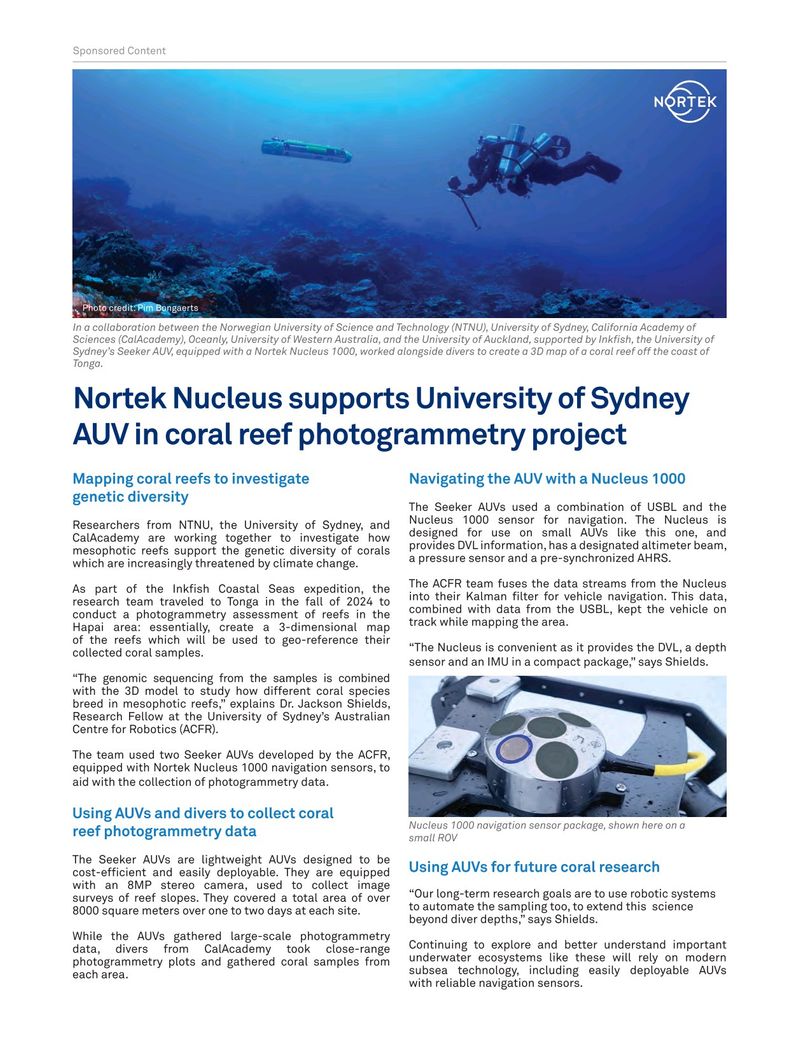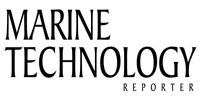
Page 5: of Marine Technology Magazine (July 2025)
Read this page in Pdf, Flash or Html5 edition of July 2025 Marine Technology Magazine
Sponsored Content
Photo credit: Pim Bongaerts
In a collaboration between the Norwegian University of Science and Technology (NTNU), University of Sydney, California Academy of
Sciences (CalAcademy), Oceanly, University of Western Australia, and the University of Auckland, supported by Ink?sh, the University of
Sydney’s Seeker AUV, equipped with a Nortek Nucleus 1000, worked alongside divers to create a 3D map of a coral reef off the coast of
Tonga.
Nortek Nucleus supports University of Sydney
AUV in coral reef photogrammetry project
Mapping coral reefs to investigate Navigating the AUV with a Nucleus 1000 genetic diversity
The Seeker AUVs used a combination of USBL and the
Nucleus 1000 sensor for navigation. The Nucleus is
Researchers from NTNU, the University of Sydney, and designed for use on small AUVs like this one, and
CalAcademy are working together to investigate how provides DVL information, has a designated altimeter beam, mesophotic reefs support the genetic diversity of corals a pressure sensor and a pre-synchronized AHRS. which are increasingly threatened by climate change.
The ACFR team fuses the data streams from the Nucleus
As part of the Ink?sh Coastal Seas expedition, the into their Kalman ?lter for vehicle navigation. This data, research team traveled to Tonga in the fall of 2024 to combined with data from the USBL, kept the vehicle on conduct a photogrammetry assessment of reefs in the
Hapai area: essentially, create a 3-dimensional map track while mapping the area.
of the reefs which will be used to geo-reference their “The Nucleus is convenient as it provides the DVL, a depth collected coral samples.
sensor and an IMU in a compact package,” says Shields.
“The genomic sequencing from the samples is combined with the 3D model to study how different coral species breed in mesophotic reefs,” explains Dr. Jackson Shields,
Research Fellow at the University of Sydney’s Australian
Centre for Robotics (ACFR).
The team used two Seeker AUVs developed by the ACFR, equipped with Nortek Nucleus 1000 navigation sensors, to aid with the collection of photogrammetry data.
Using AUVs and divers to collect coral
Nucleus 1000 navigation sensor package, shown here on a reef photogrammetry data small ROV
The Seeker AUVs are lightweight AUVs designed to be
Using AUVs for future coral research cost-ef?cient and easily deployable. They are equipped with an 8MP stereo camera, used to collect image “Our long-term research goals are to use robotic systems surveys of reef slopes. They covered a total area of over to automate the sampling too, to extend this science 8000 square meters over one to two days at each site.
beyond diver depths,” says Shields.
While the AUVs gathered large-scale photogrammetry data, divers from CalAcademy took close-range Continuing to explore and better understand important underwater ecosystems like these will rely on modern photogrammetry plots and gathered coral samples from subsea technology, including easily deployable AUVs each area.
with reliable navigation sensors.
MTR #5 (1-17).indd 5 MTR #5 (1-17).indd 5 7/29/2025 2:20:35 PM7/29/2025 2:20:35 PM

 4
4

 6
6
